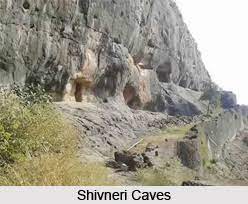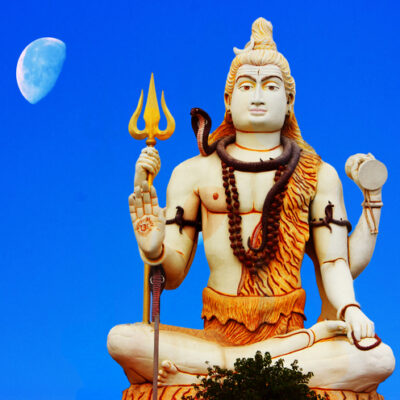Shivneri Buddhist Caves- Maharashtra

Address
Shivneri Buddhist Caves- Junnar, Shivneri Fort, Maharashtra 410502
Diety
Buddha
Introduction
The Shivneri Caves are caves for Buddhist monks circa the 1st century CE. These are located on Shivneri Hill, about 2 km Southwest of Junnar, India. The Shivneri Buddhist caves are located near Shivneri Fort on the top of the hill, where Shivaji Maharaja was born. It is a group of 50 caves that were excavated in the first part of the 1st century CE. At the beginning of the 2nd century CE, these caves were a flourishing center of Buddhist activities. The caves are essentially made of viharas or small cells, but there are also chaityas. The caves are scattered on three sides of the west-east-south triangle formed by Shivneri Mountain.
Puranic Significance
Shivneri caves are 50 rock-cut Buddhist monasteries of Hinayana school, created some 2000 years ago, in the 1st – 3rd century AD. The caves are scattered around the hill, and categorized into several groups: the East group (1, 2 and 3), the West group, and the South group. FIRST GROUP These 12 caves are located somewhat lower, in the southern side of hill. Cave 1 – vihara, consists of cell and verandah. Several cisterns in front of cave. Cave 2 – chapel with verandah and main hall which houses a shrine. Verandah initially had two pillars and two pilasters. Cave 3 – ruin small vihara, consists of forepart and small cell. Cave 4 – vihara with forepart and two cells, collapsing. Contains inscription left by donor. Cave 5 – small vihara, consists of forepart and cell. Verandah contains remnants of a much later figure of Ganesh. Cave 6 – unfinished, partly filled with soil. Possibly used for keeping cattle. Cave 7 – cell with small forepart. Cave 8 – large hall with a forepart. Seems that this cave was neither a dwelling or shrine. Cave 9 – small vihara, consists of small forepart and cell. Cave 10 – vihara, consists of forepart and three cells. Middle cell collapsed. Cave 11 – small dwelling, cell with forepart. Several cisterns nearby, some have good water. Beautiful view on surroundings. Cave 12 – cell with an open front. SECOND GROUP Consists of 25 caves, located on upper scarp of the south-eastern corner of Shivneri Hill. Cave 13 – hard to reach. Single cell with benches. Several rock-cut cisterns nearby. Cave 14 – structure with two floors. Ground floor has three parts – verandah, hall and ten cells. This part possibly was used to keep cattle. Eight steps lead to second floor. Upper floor consists of verandah and large hall. It contains inscription left by two donors. It seems that the hall in upper floor might be used as reception hall with beautiful view on surroundings. Cave 15 – open cell without verandah. Contains roughly carved shrine. Cave 16 – verandah with unfinished cell behind it. Cave 17 – verandah with unfinished cell behind it. Cave 18 – excavation similar to cell, with several cisterns at it. At this cave steps lead to the top of hill, adorned with recesses which have images of Durga, Ganesh and lost image of Batuk. Later Muslims have broken the steps and built fortification over them. Thus it is possible that Shivneri fort was used already before Muslims, by Devgiri Yadavs (1150 – 1310). Cave 19 – cell with a polished bench along the right wall. Cave 20 – open cell with cistern near it. Cave 21 – comparatively large hall with finely polished floor, walls and ceiling. Possibly this was dining hall – sattra. Cave 22 – large vihara. Consists of verandah, main hall and cells around it. Verandah contains nearly totally erased inscription. Later additions – the structure was turned into Hindu shrine. Broken image of Ganesh. One cell was polished. There was direct connection to Cave 23 through one cell, doorway is broken now. Cave 23 – consists of open verandah and hall. Verandah is partly collapsed. Carving of galloping horse with a saddle – possibly this carving was created as passtime during the polishing of wall. Use of cave is unclear, possibly it was used for learning. Cave 24 – first of Bara Gadad subgroup. Coulod be reached after climbing some 40 broken stone steps. Large vihara, left unfinished. Consists of verandah, cell to the left, partly cut hall. Although not finished, most likely it was used. Cave 25 – larger cell with broken cistern in front. Cave 26 – small cell. This cell still has traces of painting – ornament of circles. Cave 27 – vihara, consists of verandah and inner cell. In recess – shrine, round dome with a tee and umbrella. Verandah contains inscription left by donor, partly erased already at the time of creation. Cave 28 – partly joined with Cave 29. Originally there was a wall between these caves, now it is nearly broken. Two cells with remnants of painting on ceiling. Painting was simple ornament – three circles in square panels. Used white, yellow and black colors. Cave 29 – joined with Cave 28. Two cells with forepart – verandah. Both cells originally were plastered and painted – remnants of plaster still visible. Cisterns nearby. Cave 30 – large vihara, consists of partly ruined verandah, central hall and 12 cells – four cells in each wall of hall. Cave 31 – can be reached by flight of 13 stone steps. This vihara is directly connected to Cave 30. Consists of verandah and inner hall. Verandah originally had two pillars and two pilasters. Only remnants of pillars at the ceiling remain. Cave 32 – small vihara, consists of verandah and inner cell. Cave was painted – both the cell and verandah contain remnants of plaster and color. Cave 33 – vihara, consists of verandah, cell and smaller cell. Cave 34 – unfinished structure. Cave 35 – vihara, consists of hall with five cells – three in the left wall and two in the rear wall. Rear wall contains also recess where is shrine – half relief of dagoba. Cave 36 – chaitya griha – the main shrine in this group, made shortly after Cave 35. Consists of large verandah and hall with shrine. Shrine contains relief of dagoba which has style of Gotamiputra period (sometimes around 133 – 154 AD). Cave 37 – consists of verandah with broken floor. To the right from cave, there is cistern with donor inscription. THIRD GROUP This group consists of 6 caves. They are located on the west face of cliff, at the upper scarp and mostly face to the west. Cave 38 – large cell with several unaccessible cisterns nearby. Ceiling of cell has remnants of plaster, appears to be painted. Walls have recent plaster, cave has also some comparatively new stone and clay works. Cave 39 – simple cell. Cave 40 – simple cell with a bench. Cave 41 – vihara, consists of three parts – verandah, main hall and four cells. Two cells are in rear wall, one in left and one in right wall. Five cisterns near the cave. Cave 42 – small cell with forepart. Ceiling has remnants of plaster and painting. Cave 43 – large hall with verandah. Verandah has two pilasters, originally it had four columns as well. It is possible that pillars were broken during the construction . FOURTH – SOUTHERN GROUP Seven caves in the lower part of the upper scarp. These caves face to the south. Cave 44 – initial Buddhist cave turned into Hindu shrine. Consists of a large verandah and hall. Verandah is large, with two side buttresses – stone masonry structures built in later times. Hall is comparatively large, some 6 m long and 6 m wide and roughly 2.8 m high. At the rear wall, there is a stone altar for Hindu goddess Shiva, the family deity of the famous Marathi warrior Shivaji (1630 – 1680) born in Shivneri fort. Cave 45 – small vihara, consists of verandah and a cell. Front pilasters of the verandah are broken. Possibly was used by Marathas as storeroom. Cave 46 – vihara, consists of open verandah and cell. The rear wall of the verandah has inscription left by donor. Cave 47 – vihara, consists of verandah, cell in the right wall of verandah and small cell in rear wall. Cave 48 – Hall with open front, with two pillars similar to pilasters. The left wall has inscription left by a donor, it is ending with swastika. Cave 49 – small viharam consists of open verandah and inner cell, not finished due to bad rock. Cave 50 – large chaitya with flat roof. Consists of a verandah, hall to the right and shrine. Verandah initially had two pillars and two pilasters.
Century/Period/Age
1st – 3rd century AD.
Managed By
Archaeological Survey of India (ASI)
Nearest Bus Station
Junnar
Nearest Railway Station
Talegaon
Nearest Airport
Pune









